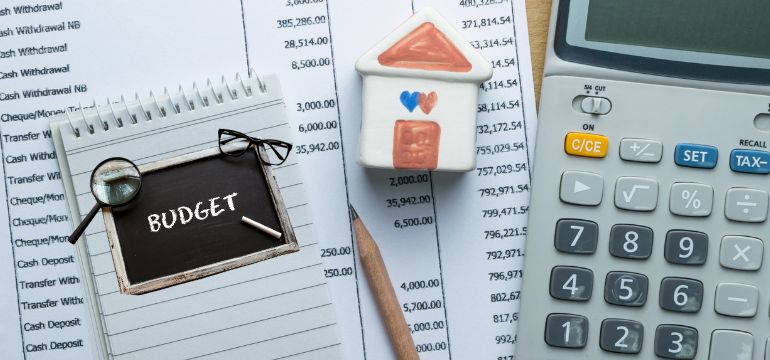
Creating a family budget is a vital step towards achieving financial stability and ensuring that your family’s needs are met both now and in the future. A budget helps you manage your money effectively, save for future goals, and prepare for unexpected expenses. Here’s how to create a family budget that works, emphasizing the importance of paying yourself first, saving, and living within your means. Additionally, we’ll explore the advantages and disadvantages of buying things in bulk versus buying them little by little.
The Importance of Paying Yourself First
Paying yourself first means setting aside a portion of your income for savings before spending on anything else. This practice is crucial for several reasons:
Ensures Consistent Savings: By prioritizing savings, you guarantee that a part of your income is always directed towards your financial goals, such as an emergency fund, retirement, or education.
Builds Financial Discipline: Paying yourself first helps develop a disciplined approach to managing money. It reduces the temptation to spend on non-essential items and encourages long-term financial planning.
Creates a Safety Net: Having savings set aside provides a cushion for unexpected expenses, reducing the likelihood of falling into debt during emergencies.
Saving and Living Within One’s Means
Living within your means involves spending less than you earn and avoiding debt. This approach is fundamental for financial health:
Financial Stability: Spending within your means ensures that you can cover your necessary expenses without relying on credit, leading to a more stable financial situation.
Reduced Stress: Knowing that you are not overspending and have control over your finances reduces anxiety and stress related to money.
Long-Term Benefits: Living within your means allows for steady growth in savings and investments, contributing to a secure financial future.
Buying in Bulk vs. Buying Little by Little
When managing a family budget, decisions about purchasing can have a significant impact. Here are the advantages and disadvantages of buying things in bulk compared to buying them little by little.
Buying in Bulk
Advantages:
- Cost Savings: Bulk purchases often come at a lower per-unit cost, saving money in the long run.
- Convenience: Reduces the frequency of shopping trips, saving time and effort.
- Stockpiling: Ensures that you always have essential items on hand, reducing the risk of running out.
Disadvantages:
- Upfront Cost: Requires a larger initial expenditure, which might strain the budget if not planned properly.
- Storage Space: Needs adequate storage space to keep bulk items, which can be a challenge in smaller homes.
- Waste: Risk of items expiring or going unused, leading to waste if not properly managed.
- Tendency to Use More: Having large quantities of items on hand can lead to using them more liberally, potentially increasing consumption and reducing the anticipated savings.
Buying Little by Little
Advantages:
- Lower Immediate Costs: Smaller, more manageable expenses that are easier to fit into a weekly or monthly budget.
- Less Storage Required: Requires less storage space, making it more suitable for smaller living spaces.
- Flexibility: Allows for more flexibility in spending and adapting to changes in needs and preferences.
- Tendency to Save: Buying items in smaller quantities often encourages more mindful consumption and careful usage, potentially leading to overall savings.
Disadvantages:
- Higher Per-Unit Cost: Often more expensive per unit compared to bulk purchases.
- More Frequent Shopping: Requires more frequent trips to the store, which can be time-consuming and potentially lead to impulse buying.
- Risk of Shortages: Higher risk of running out of essential items, especially if shopping trips are missed.
Step-by-Step Process to Create a Family Budget That Works
Creating a family budget that works involves several crucial steps. Here’s a step-by-step guide to help you establish a budget that promotes financial stability and aligns with your family’s goals.
Step 1: Assess Your Income
Gather Income Information:
- List all sources of income, including salaries, bonuses, freelance work, and any other earnings.
- Calculate the total monthly income for your household.
Step 2: Track Your Expenses
Categorize Your Spending:
- Fixed Expenses: Rent/mortgage, utilities, insurance, loan payments.
- Variable Expenses: Groceries, dining out, entertainment, transportation.
- Periodic Expenses: Annual insurance premiums, car maintenance, property taxes.
Record Every Expense:
- Keep track of every expense for at least one month. Use a notebook, spreadsheet, or budgeting app to log all purchases and payments.
Step 3: Set Financial Goals
Short-Term Goals:
- Build an emergency fund.
- Save for a family vacation or a new appliance.
Long-Term Goals:
- Save for retirement.
- Plan for children’s education.
- Pay off a mortgage or other significant debts.
Prioritize Goals:
- Determine which goals are most important and set realistic timeframes for achieving them.
Step 4: Create a Savings Plan
Pay Yourself First:
- Decide on a percentage of your income to save each month before paying other expenses.
- Automate savings transfers to ensure consistency.
Emergency Fund:
- Aim to save 3-6 months’ worth of living expenses in an easily accessible account.
Investment and Retirement:
- Contribute to retirement accounts (401(k), IRA) and other investment vehicles.
Step 5: Develop Your Budget
Allocate Income to Categories:
- Assign portions of your income to each expense category based on your tracked spending and financial goals.
- Ensure that total expenses do not exceed total income.
Create Spending Limits:
- Set specific spending limits for variable expenses to avoid overspending.
Step 6: Implement and Adjust Your Budget
Monitor Your Spending:
- Regularly review your spending to ensure you are within budget limits.
- Adjust categories and limits as needed based on actual spending patterns.
Make Adjustments:
- If you find certain categories consistently exceed the budget, consider reallocating funds or reducing spending in other areas.
Review Periodically:
- Conduct a monthly review to assess progress towards financial goals and make necessary adjustments to the budget.
Step 7: Plan for Unexpected Expenses
Build a Buffer:
- Include a miscellaneous category in your budget for unexpected expenses.
- Replenish the buffer each month if used.
Adjust Savings as Needed:
- If unexpected expenses arise, adjust your savings plan temporarily to accommodate them without disrupting other financial goals.
Step 8: Engage the Whole Family
Communicate:
- Discuss the budget with all family members to ensure everyone understands and agrees with the financial plan.
Involve Everyone:
- Encourage family members to participate in budgeting decisions and tracking expenses.
Set Family Goals:
- Establish common goals to foster teamwork and commitment to the budget.
Step 9: Stay Flexible and Adaptable
Expect Changes:
- Life circumstances can change, requiring adjustments to your budget. Stay flexible and be prepared to adapt as needed.
Celebrate Milestones:
- Recognize and celebrate when you achieve financial goals or successfully stick to your budget. This will keep the family motivated.
By following these steps, you can create a comprehensive and adaptable family budget that supports your financial well-being and helps you achieve your financial goals.
What to Look for in a Healthy Budget
A healthy budget includes several key components that ensure its effectiveness and sustainability:
1. Realistic Income Assessment: Accurately calculate your total household income, including salaries, bonuses, and any other sources of income.
2. Comprehensive Expense Tracking: List all your expenses, including fixed costs (rent/mortgage, utilities, insurance) and variable costs (groceries, entertainment, dining out).
3. Savings and Investment Goals: Allocate a portion of your income to savings and investments. Include short-term (emergency fund) and long-term (retirement, college funds) goals.
4. Debt Management: Plan for debt repayment. Prioritize paying off high-interest debt first and aim to reduce overall debt levels.
5. Adjustable Categories: Ensure your budget is flexible enough to accommodate unexpected expenses and changes in income or costs.
6. Periodic Review: Regularly review and adjust your budget to reflect changes in your financial situation, goals, and priorities.
Conclusion
Creating a family budget that works is not just about tracking expenses—it's about setting priorities, being disciplined, and planning for the future. By paying yourself first, saving consistently, and living within your means, you can achieve financial stability and peace of mind. Whether you choose to buy in bulk or little by little, make sure your decisions align with your budget and storage capabilities. Remember, a healthy budget is one that is realistic, flexible, and regularly reviewed to ensure it continues to meet your family’s financial needs and goals.
LATEST BLOGS
Recognizing and Addressing Depression in Teens
Recognizing and addressing depression in teens is vital for their overall well-being and development. By understanding the signs and providing the necessary support,
Top 5 Books for New Parents: A Comprehensive Guide
Becoming a new parent is an exhilarating and often overwhelming experience. To help you on this journey, we’ve curated a list of the top five essential books for new




0 COMMENTS
Please log in to comment